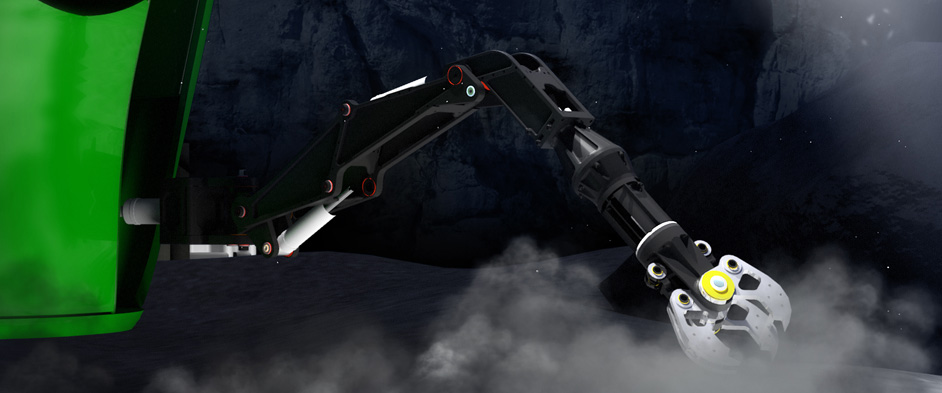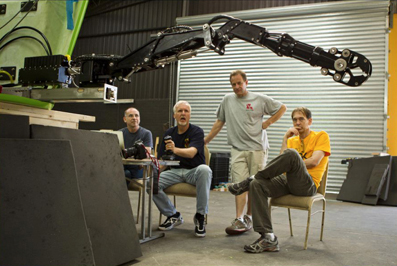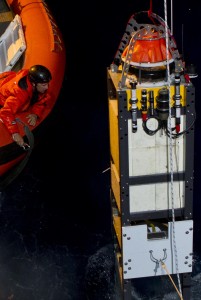EQUIPMENT

MECHANICAL ARM
When the pilot encounters something he’d like to collect or examine, a hydraulic arm will emerge from the payload bay. Controlled by a joystick, it’s a real-life version of the mechanical limbs Cameron created for his films Aliens and Avatar. He’ll use the gripper to pick up rocks and deep-sea creatures and will then deposit them into a “biobox”—a thick plastic box with a close-fitting lid designed to keep samples cool. He’ll also be able to use the arm to take push core samples. The arm will insert a plastic tube into a soft part of the ocean floor and will use a device to pull out a sample of the sediment layers in the top few inches of the ocean bottom, thought to be the home of unidentified species of microbes representing one of the largest biomasses on Earth.

Photograph courtesy James Cameron
James Cameron and team test the DEEPSEA CHALLENGER’s mechanical arm.
ANDERS
Resembling tall, skinny phone booths, landers are unmanned robotic vehicles that descend to the seafloor, perform pre-programmed tasks, and return to the surface. The DEEPSEA CHALLENGE expedition has two landers, each able to dive to the ocean’s greatest depths. Like the submersible, they descend vertically. Dives can last 30 hours, and the landers can be deployed as a kind of “advance party.” Using its tracking systems, the DEEPSEA CHALLENGER can rendezvous with the landers during a dive, and when in the sub, Cameron or Allum can trigger some of the landers’ functions via the surface.

Photograph by Mark Thiessen
The crew tests one of two unmanned landers that will be released to the bottom prior to the sub.
The landers share many of the systems and components developed specially for the DEEPSEA CHALLENGER itself—buoyant syntactic foam, external pressure-balanced batteries, LED light “bricks,” 3-D HD cameras, and acoustic tracking and command systems. They use a burn wire system to release iron ballast weights, enabling them to return to the surface. Once there, strobes, radio beacons, and GPS location transmitters help the support ship to find the landers and bring them aboard.
For scientific sampling, the landers carry a versatile payload that can collect deep-ocean water and capture small animals. For water sampling, Niskin bottles are used. These are thick plastic pipes with two large bungs that spring tightly shut upon acoustic command from the surface. Baited traps capture mobile animals like crustaceans and small fish. The traps are mounted at the end of a large arm that swings down to the seafloor after release by a timed burn wire.
The landers are set up to film and photograph the seafloor environment and the submersible using a pre-programmed sequence that generates time-lapse images over many hours. The images will reveal the deep-sea animals that visit the dive site—data that scientists can analyze to better understand the deep-sea community. One lander carries two camera systems: a high-resolution still camera enclosed in an immensely strong glass sphere and 3-D HD cameras in twin titanium housings. Attached to a tilt mechanism, the 3-D camera is programmed to scan up toward the submarine and down toward the lander’s bait arm deployed on the seafloor.
CAMERAS
When filming, the pilot will share the pilot sphere with three cameras. The largest is a Red Epic, which will capture IMAX-quality, “5K-raw” images and will be mounted directly in front of the small viewport on the sphere’s hatch. That window—which from the inside is only about the size of a fist and is just below the pilot’s knees—will be awkward for pilots Cameron or Allum to look through on their own. But the window is cone-shaped and is much larger on the side that faces the ocean’s pressure. The curvature of the window also corrects for the 30-percent magnification that water causes. With the camera attached and its image projected onto a high-definition screen at the pilot’s eye level, he’ll get a wide view of his surroundings through this “virtual viewport.”
Inside the sphere, two tiny HD cameras (two are needed to create 3-D video) will also film the pilot himself. Because these cameras will record his “dive log,” they will also help the team understand the context of the footage that the other cameras are gathering at the same time. The sub’s external cameras, the minicams, are tiny HD cameras built specially for this project from the sensor level up and housed in proprietary titanium housings. Enclosed in their titanium pressure housings, these HD cameras are smaller than a soda can. Two of them side by side can create 3-D, as with the cameras on the end of the 6.6-foot (2-meter) camera boom. Another two are side by side on the wrist of the manipulator arm, but in this case one has a wide-angle lens and the other a macro lens for imaging small animals up close, so that they’re both working as separate 2-D cameras. Another single minicam will be carried by the “bot,” a small remotely operated vehicle that the pilot can command from inside the sub.



